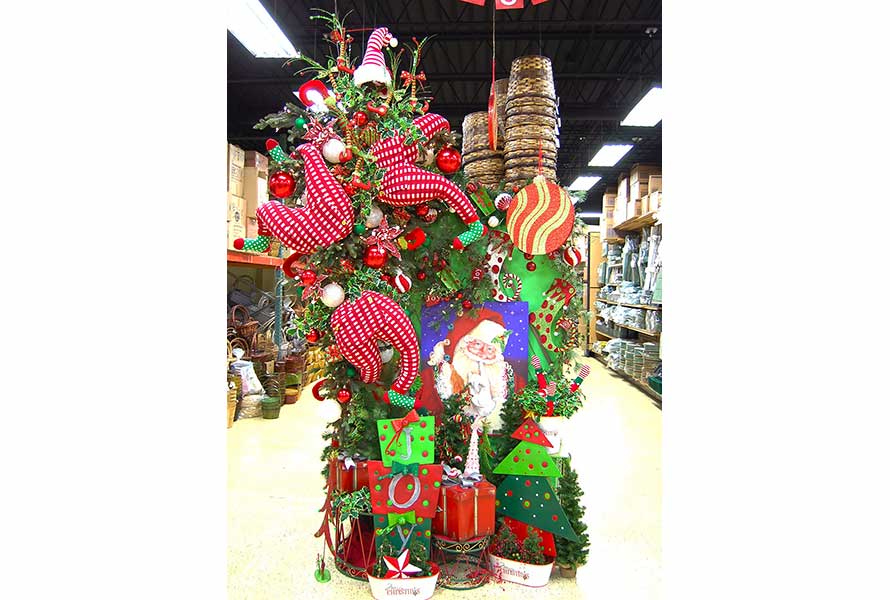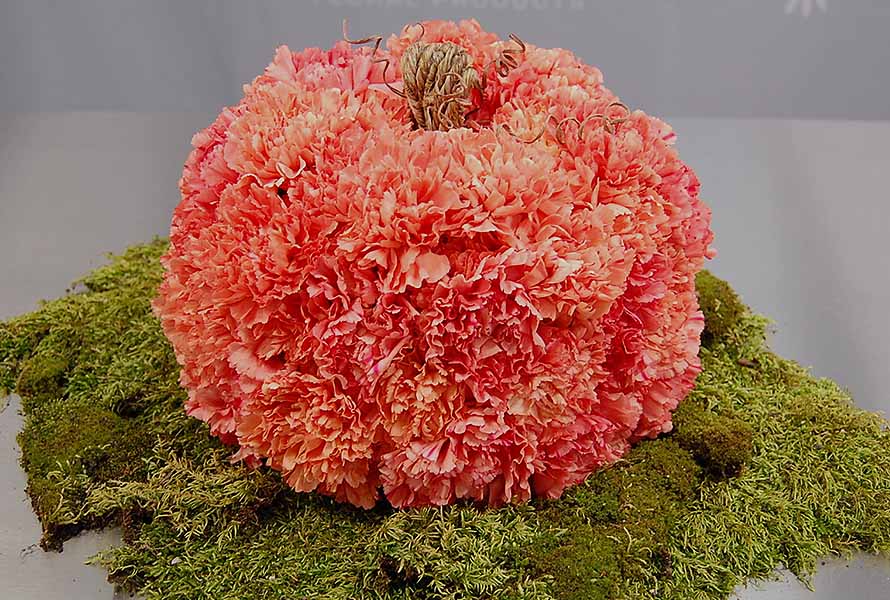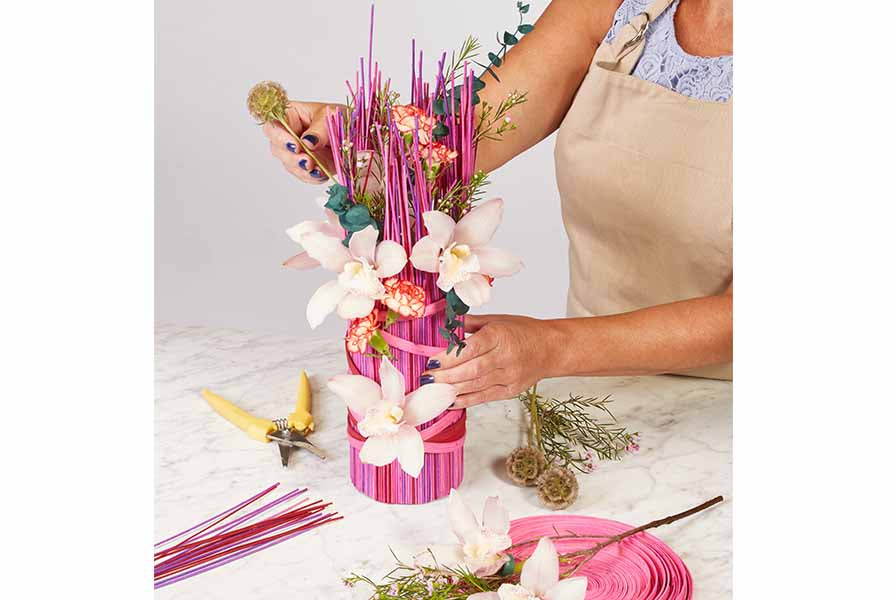How can you increase holiday sales? Upsell floral designs and products? Enlist silent “salespeople”?
End caps.

Previously, we've discussed merchandising elements such as product placement, ‘grab & go' table displays, vignettes, product mix percentages and selling to trend.
End cap displays are equally important in showing customers how to use your products in their homes and businesses or events, especially for the holidays.
Even if you don’t have a physical location, you can create sales buzz by building displays and sending photographs out by email and social media.
What are the keys to successful end caps?
Tell a story and mind the details are two of them. Everything your customer sees in your floral business tells a story.
I recently presented a holiday design program at
North American Floral Wholesale in Sioux Falls, South Dakota, along with Gerard Toh AIFD.
The company’s attractive holiday merchandising end caps were creating buzz among the attendees. I asked Assistant Supply Manager Rachel Hettich, who has more than three decades of experience in customer service, buying product and merchandising, to share her design secrets for building effective displays.
She offered these six suggestions.
1. Plan an open house, introduce trends and themes
[rev_slider alias="sizzling-holiday-1"]
“Our open houses are the main reason we do end caps so our customers will see new products in use,” says Rachel. “We have two large open houses a year, in the spring and holiday seasons.”
Savvy shoppers are looking for the same ease of purchase and diversity of product in physical stores that they experience online. When properly executed, a holiday open house offers the fun of attending an event with friends and the ease of buying on-site the products they’re looking for.
Trends and themes are established using color and texture to deliver direct sales messages that connect with the customer. This introduces florists to the season’s new trends and offers early access to materials needed for creating their seasonal designs.
“In the wholesale world, buying and planning are done six months to a year in advance with holiday displays planned in January and set up in June or July,” she explains. She sets up spring displays in February.
Coordinate your merchandising and open houses with your customers’ buying habits for that season.
2. Drive sales with end caps
[rev_slider alias="sizzling-holiday-2"]
An end cap is a merchandising display or vignette at the end of an aisle that shows how products can be used. While the surrounding shelves are filled with products, often in boxes, the end cap "actively"
merchandises: it encourages sales by showcasing how products can be used.
to openly display products to sell and showcase how they can be used.
Like a miniature billboard, an end cap communicates a sales message directly to the customer. These “silent salespeople” can drive sales for the products displayed.
Buying is always an emotional act, so telling a merchandising story the customer can relate to makes a mental connection that can result in increased buys.
End caps can also be used to promote easy ‘grab and go’ buys of basic seasonal merchandise such as
ribbon,
containers, candles,
new products or novelty items.
One unique idea that works for Rachel is to display a group of sell sheets in a rack in the sales area. “We print end cap sheets for each section that feature a picture of the end cap and the list of products used. A lot of customers purchase endcap product directly from those sheets to reproduce the look in their store.”
Creating end cap sell sheets for your shoppers may aid in their purchase of products and designs and offer them a photo guide for duplicating your decorating idea.
3. Buy with themes in mind
[rev_slider alias="sizzling-holiday-3"]
“Most often, you buy product with a certain theme in mind, “says Rachel. “Customers love it when you are creative and original with a basic product!”
In your themes, carefully blend a variety of product sizes and prices to offer something for everyone. Create coordinating floral arrangements: door, mantle, centerpiece, etc., to inspire impulse sales. Mix design materials with finished designs to encourage DIY sales.
Rachel suggests building displays that appeal to the customers in your area rather than simply following market trends. “Our styles and trends in the Midwest are different from those on the east or west coasts.”
You can catch customer’s attention by designing a variety of end caps with different themes to appeal to their personal likes for a specific activity, hobby, style or color as seen in the Lakeside Christmas display in a photo above.
The focus of every endcap differs based on what is considered most intriguing in that section. A prop,
product or fabric might be the catalyst for developing a theme. A strategic mix of similar items, both old and new, are blended to complete the visual story and create profitable sales at the same time.
4. Scale displays to your store size
From mom and pop businesses to big box stores, end cap displays can play a primary role in guiding holiday sales. You can adapt display size to your store size or display space.
As the following photos illustrate, smaller displays over the register, above shelving units or on blank wall space can be designed to showcase product—and be priced to sell in case a shopper is looking for an oversized design
. Shops often hesitate to make large designs due to cost. However, when they do, the large items do sell.
Many small shops use old doors or wooden partitions covered in fabric or other materials to serve as end cap design space. Placing the backdrop on a sturdy base and adding wheels allows for the display to be moved as the area is reconfigured.
5. Pull it all together
[rev_slider alias="sizzling-holiday-4"]
Rachel seeks inspiration for her merchandising themes, colors and designs in floral, furniture and decor publications, on Pinterest and Facebook, and shopping the Dallas and Atlanta markets twice a year.
To pull it all together, she creates her merchandising stories, then relies on co-workers to help complete the displays. Hauling props, pulling product, listing the items used for end cap recipes and assisting with placement is a company-wide project with everyone pitching in.
What does she think is the most important sales technique in a floral business?
6. Pay attention to detail
Rachel has spent 31 years in retail, wholesale and overseas product development jobs focusing on customer service, buying product and building displays.
“This work experience taught me that
paying attention to detail is most important,” she says. It sets you apart from your competition. Rachel has used this skill for the past nine years at North American and it is evident in her merchandising displays.
Her advice to retailers?
Increase your holiday sales by telling a story that connects with the customer and teaches them how to use the products you sell.
“Show your customers how to create small vignettes in their homes with the products they purchase in your store and offer them ideas on how to use new items along with what they already have.”
Rachel believes that if they feel you "get" them and provide great products, they will come back to you for advice on future purchases.
How can you create a merchandising story that connects with your customers?
For more details on creating merchandising displays, download my Create a look that attracts handout.
 Previously, we've discussed merchandising elements such as product placement, ‘grab & go' table displays, vignettes, product mix percentages and selling to trend.
End cap displays are equally important in showing customers how to use your products in their homes and businesses or events, especially for the holidays.
Even if you don’t have a physical location, you can create sales buzz by building displays and sending photographs out by email and social media.
Previously, we've discussed merchandising elements such as product placement, ‘grab & go' table displays, vignettes, product mix percentages and selling to trend.
End cap displays are equally important in showing customers how to use your products in their homes and businesses or events, especially for the holidays.
Even if you don’t have a physical location, you can create sales buzz by building displays and sending photographs out by email and social media.
 Previously, we've discussed merchandising elements such as product placement, ‘grab & go' table displays, vignettes, product mix percentages and selling to trend.
End cap displays are equally important in showing customers how to use your products in their homes and businesses or events, especially for the holidays.
Even if you don’t have a physical location, you can create sales buzz by building displays and sending photographs out by email and social media.
Previously, we've discussed merchandising elements such as product placement, ‘grab & go' table displays, vignettes, product mix percentages and selling to trend.
End cap displays are equally important in showing customers how to use your products in their homes and businesses or events, especially for the holidays.
Even if you don’t have a physical location, you can create sales buzz by building displays and sending photographs out by email and social media.



Leave a comment
This site is protected by hCaptcha and the hCaptcha Privacy Policy and Terms of Service apply.